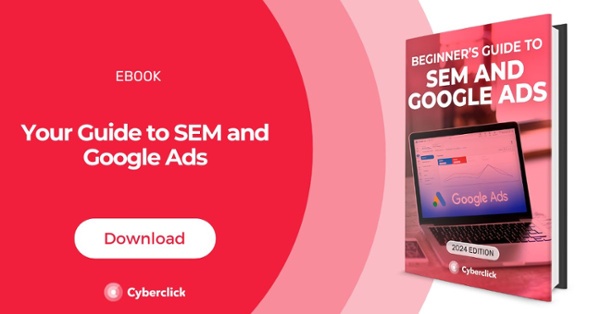- Home
- Cyberclick Academy
- SEM
- SEM Campaign
What Is a SEM Campaign? Definition, Advantages, and Examples
SEM Content
- What Is SEM? Definition, Advantages, Disadvantages, and Key Concepts
- SEO and SEM: Definition, Differences, and Combined Use
- SEM Positioning: Definition, Characteristics, and Advantages
- What Is a SEM Campaign? Definition, Advantages, and Examples
- What Is Search Engine Marketing? Definition and Basic Concepts
- How to Create a SEM Marketing Strategy for Your Company Step by Step
- How to Set Up and Optimize SEM Campaigns on Google Ads and Their Benefits
Index
SEM stands for search engine marketing. Though most marketers refer to it as a web positioning strategy, it's more than that because it encompasses everything related to web positioning. In fact, there are even companies that refer to SEM as search engine advertising (SEA).

SEM has gained importance over recent years. In today's digital world, we all use search engines almost daily. As a result, search engine positioning is important to increase traffic and gain visibility. Two ways to reach the top positions are:
-
Organic positioning (SEO). This strategy focuses on creating relevant content and optimizing it to rank high on search engine results. Keeping that in mind, a new strategy called omnisearch optimization (OSO) has emerged as a result of the rise of diverse digital search behaviors. OSO extends SEO by optimizing content across a variety of platforms beyond traditional search engines, such as social media, video sites, and chat tools. It ensures your brand reaches users across multiple digital spaces, boosting visibility and engagement in a fragmented digital ecosystem.
-
Payment strategies (SEM). SEM means that you pay for the keywords you need so that you appear in the top search position. Unlike organic listings, here the advertiser must pay a fee for each click they get. To get traffic by buying ads on search engines, you will have to turn to search engine advertising, such as Google Ads. This strategy is also called PPC (pay-per-click) or CPC (cost-per-click).
What Is a Search Engine Marketing or SEM Campaign?
A SEM campaign is an advertising strategy that generates ads in search engines like Google to position brands among the top results.
Strategy and planning are fundamental to ensure success following your SEM campaign, so let's take a look at some of the key aspects for launching a successful campaign in Google Ads.
- Keywords. When planning an SEM campaign, keyword research should always be one of the first steps. To get search engines to put your sponsored link first, you must buy the keywords users will search to find you. When a user types those words in the search engine, your website will show up as the ads activate (if the words entered coincide with the ones on your site). For example, if someone searches for "mountain boots" the first result will be a URL with an "advertisement" icon. This indicates that the company has bought the keywords "boots" and "mountain." Keep in mind that you need to investigate your target audience before deciding which keywords you want to utilize.
- Clicks. Clicks are redirected from the ad to your landing page. In other words, how many people have seen and clicked on the ad.
- CPC. The bid or purchase of an advertisement within Google Ads works through CPC. You can define a maximum CPC to stay within your budget.
- Pay-Per-Click. PPC is one of the advantages of SEM campaigns on Google Ads. You can decide what you want to pay for each click, and will only be charged when a user clicks on your link.
- Impressions. This refers to the number of times an ad has been shown. In other words, how many searches for a specific keyword have prompted your ad to be displayed. This data is readily available on Google.
- Relevance. Although you might pay to appear in top positions, Google always takes users into account. The content has met the users' needs, and they have to find the ad relevant and want to interact with it. If this happens, Google will help you get more traffic and more customers.
- CTR or Click-Through Rate. This is the percentage of people who saw your ad and interacted with it. If you have a good CTR, you have successfully created ads favored by Google.
- Quality Score or Quality Level. This is a score that Google gives you on a scale from 1 to 10. It determines if you are a successful advertiser depending on the relevance of your ads. The goal is to stay above 7.
How to Select SEM Keywords for Your Campaign
When planning a SEM campaign, keyword research should always be one of the first steps. Keywords are the foundation on which SEM accounts, ads, and even landing pages are built.
To carry out a keyword study for SEM campaigns, take note of the following steps.
Analysis of the Product, Service, or Landing Page
Keywords should always be relevant to the product or service you are offering. Therefore, the first step is to draw up a list of two to ten main ideas that summarize the services or products you offer. In addition to studying your own offer, also take a look at your competitors' sites.
Using Keyword Tools
There are many keyword planning platforms on the market, such as SemRush or Google's keyword tool. If you enter the basic ideas you defined in the previous section, the tool will provide a list of related keywords. To filter the results, you can segment by location and language.
One of the benefits of these tools is that they help with brainstorming and can give you a lot of suggestions that you would never have thought of. Of course, they can also offer suggestions that are not exactly related to the original search, which brings us to the next step.
Filtering and Selecting
From the list of keywords provided by the tool, you will have to filter out irrelevant words, group related keywords, and select those that have the highest number of searches and the lowest competition (meaning there aren't many advertisers bidding for the same word).
Once you do this, you will have the definitive list of keywords to optimize your SEM campaign. To get the best results, these keywords should be present both on your landing pages and in your ads.
Advantages of Creating SEM Campaigns for Your Business
Search engine marketing is a powerful tool that is suitable for almost all brands. In order for you to better evaluate when and how to include it, here are its main advantages:
- Greater segmentation. The more segmented a campaign is, the better your chance of reaching your target audience. Google Ads allows you to segment your audience and create campaigns taking into account different characteristics such as gender, age, geographical location, interests, and even hobbies.
- Attracting traffic to your website. The campaign's main goal is to appear in the top results of search engines to generate even more traffic to your website.
- Monitoring and measuring. Thanks to Google Ads, you can monitor the results of your campaign at all times. You can get detailed information on user behavior, the number of clicks, impressions, and more.
- Complementing SEO. By combining SEM and SEO you will have a complete digital marketing strategy. Neither SEM nor SEO is better. It's actually the combination of the two that makes a strong digital strategy.
- Controlling costs. When implementing a SEM campaign, you will have a high level of control. You can set the budget and only pay when the users interact with your ads.
- Lead capture. The main function of SEM is to provide answers to people who have a need you can solve, in other words, your target audience. This can lead to conversions and to building customer loyalty.
Most Important SEM Metrics
As with any other type of digital marketing, in SEM you can only optimize what is measured. That's why, before launching your strategy, you need to know which KPIs to look at to evaluate the performance of your campaigns.
Here are four key metrics to measure the success of your SEM campaigns.
Quality Score
The quality score measures the user experience with the ads, so the higher the quality score, the better the user experience. This metric is essential because Google Ads uses it to determine the cost and placement of ads.
The quality score depends on three factors:
- The quality of the landing page.
- The quality of the advertisement.
- The expected click-through rate.
Impression Share
The share of impressions tells you if users are seeing your ads. It is calculated based on the impressions obtained by an ad compared to the total number it could get.
A low impression share indicates that you are not taking full advantage of the ad. To remedy this, you need to raise the budget and bids, improve the quality score, or both.
Click-Through Rate (CTR)
The click-through rate indicates the frequency with which users who see an ad end up clicking on it. To calculate it, divide the number of clicks by the number of impressions. For example, if you have 5 clicks and 100 impressions, the CTR would be 5%.
Look at this metric for the different ads and keywords in your account. A low CTR indicates that the ad is not attractive enough for the user or that it is not really relevant to their search.
Conversions
The number of conversions and the average value of each one allow you to measure the performance of your ads, as it indicates how many sales they have generated. This way, you will be able to correctly attribute the ROI (rate of interest) of your SEM campaigns and measure their profitability.
To get the best results from your SEM campaigns, we recommend that you look for a Google Partner-certified agency, like ours!
Recursos para seguir aprendiendo: ebooks, vídeos y cursos

Cyberclick

Cyberclick

Cyberclick

Cyberclick

Cyberclick


